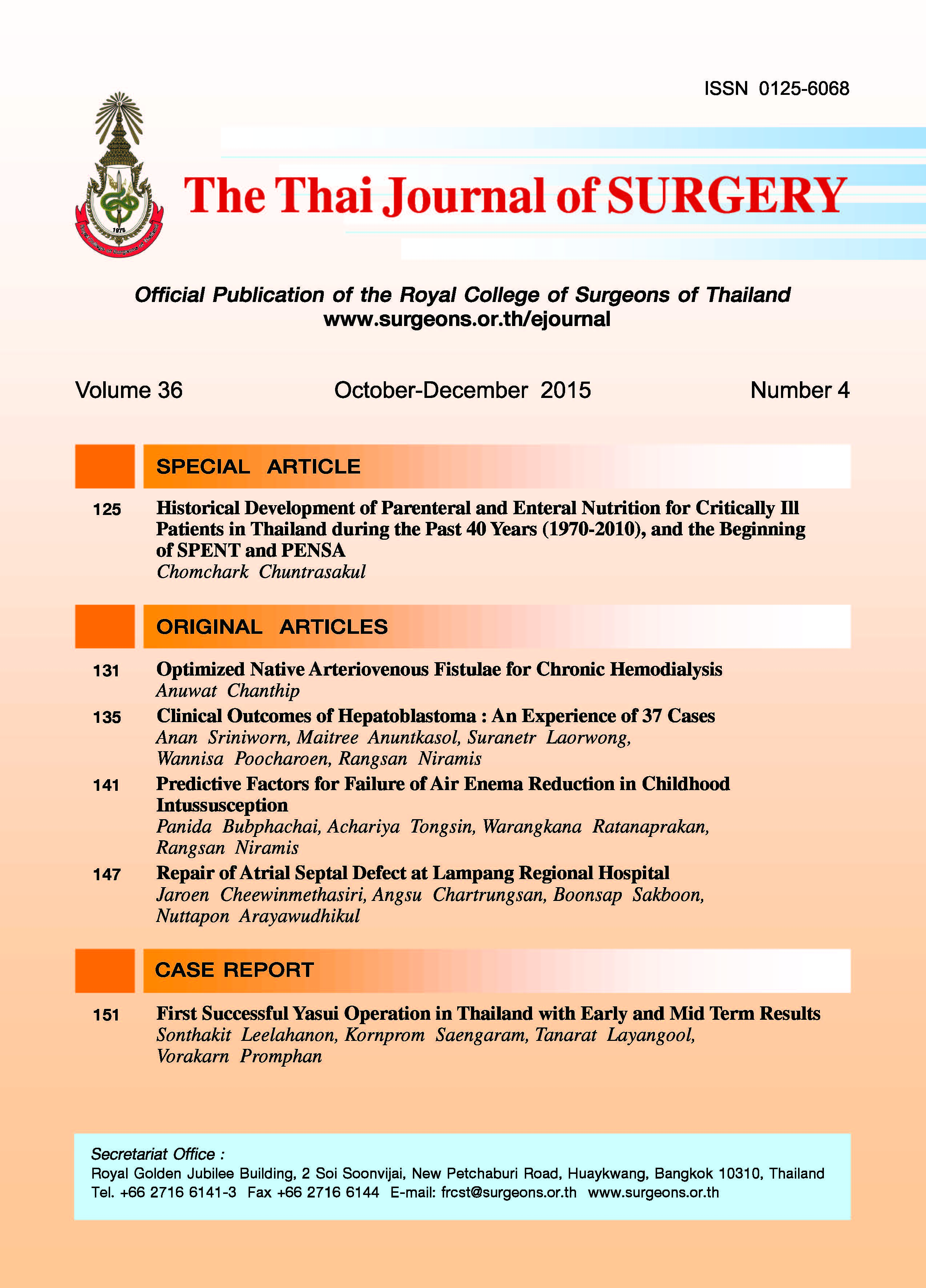Optimized Native Arteriovenous Fistulae for Chronic Hemodialysis
Keywords:
Native arteriovenous fistulae, hemodialysis, duplex imagingAbstract
Background and Objective: The arteriovenous fistulae (AVF) is the preferred vascular access for hemodialysis interms of superior primary patency, longer access survival and decrease morbidity and mortality compared with AV grafts.
Recent clinical practice guideline (NKF/DOQI) advocates increase native AVF to achieve 65%. This study was attempted
to create native arteriovenous fistulae with simple preoperative assessment and criteria for both new hemodialysis and
previous permanent access patients.
Objective: The purpose of this study was to delineate preoperative assessment and operative procedure for
native arteriovenous fistulae to meet primary patency and sufficiency for hemodialysis.
Material and methods: Prospective study design was carried out at Lampang Regional Hospital between April
2005 and Nov 2010 by one surgeon. Preoperative assessments comprised of physical examination and duplex imaging
study of vein and artery of non-dominant upper extremity first. The criteria are wrist vein diameter > 2.5 mm, arterial
diameter > 2.0 mm with no inflow and outflow stenosis. The creation of arteriovenous fistulae was regarded on the results
of physical examination and preoperative duplex imaging. If the arteriovenous fistulae failed to mature, remedial
imaging before re-intervention was performed.
Result: One hundred seventy-five patients with total 209 procedures were included in this study. Majority of the
new hemodialysis cases had prior catheter placement for chronic hemodialysis. Total new hemodialysis, 149 patients,
had first visit at Lampang Regional Hospital. One hundred forty-seven native AVF creation (98.6%) were performed with
radiocephalic (77.8%), brachiocephalic (16.7%), forearmbasilic transposition (0.0067%), arm basilic transposition
(0.0067%) and basilic superficialization (0.0268%). New hemodialysis patients had unsuitable criteria of duplex imaging
for eight cases, only two cases were decided to operate with loop forearm AVBG. Twenty-six patients had at least one
arteriovenous fistulae procedure from other hospital and had remedial procedure for 21 native AVF creation (80.7%)
and 5 prosthetic graft (19.2%). One hundred forty-one native AVF matured after first creation, 22 patients needed
remedial procedure, 3 patients needed 2 times of remedial procedure and 2 patients needed 3 times. All of these AVF
patients had no mortality and limited number of complication such as thrombosis, bleeding and postoperative edema.
Conclusion: On the basis of native AVF creation first, with simple preoperative assessment. Optimized native
AVF can reach over DOQI recommendation.
References
access morbidity. J Am Soc Nephrol 1996;7:523.
2. Ascher E, Gade P, Hingorani A, et al. Changes in the
practice of angioaccess surgery: impact of dialysis outcome
and quality initiative recommendations. J Vasc Surg 2000;31:
84.
3. Allon M, Robbin ML. Increasing arteriovenousfistulas in
hemodialysis patients: problems and resolutions. Kidney Int
2002;62:1109.
4. Dixon BS, Novak L, Fangman J. Hemodialysis vascular access
survival: upper arm native arteriovenous fistula. Am J Kidney
Dis 2002;39:92.
5. NKF-K/DOQI Clinical Practice Guidelines For Vascular Access:
Update 2006. Guideline 8: Clinical outcome goals, 8.1 goals
for access placement, 8.1.2 prevalent functional AVF
placement rate.
6. Sidawy AN, Spergel LM, Besarab A, et al. The Society for
Vascular Surgery: clinical practice guidelines for the surgical
placement and maintenance of arteriovenous heodialysis
access. J Vasc Surg 2008;48:2S.
7. Ascher E, Gade P, Hingorani A, Mazzariol F, Gunduz Y,
Fodera M, et al. Changes in the practice of angioaccess
surgery: impact of dialysis outcome and quality initiative
recommendations. J Vasc Surg 2000;31:84-92.
8. Allon M, Lockhart ME, Lilly RZ, Gallichio MH, Young CJ, Barker
J, et al. Effect of preoperative sonographic mapping on
vascular access outcomes in hemodialysis patients. Kidney
Int 2001;60:2013-20.
9. Mihmanli I, Besirli K, Kurugoglu S, Atakir K, Haider S, Ogut G,
et al. Cephalic vein and hemodialysis fistula: surgeon’s
observation versus color Doppler ultrasonographic findings.
J Ultrasound Med 2001;20:217-22.
10. Silva MB Jr, Hobson RW, Pappas PJ, Jamil Z, Araki CT,
Godberg MC, et al. A strategy for increasing use of
autogenous hemodialysis access procedures: impact of
preoperative non invasive evaluation. J Vasc Surg 1998;
27:302-7.
11. Miller A, Holzenbein TJ, Gottlieb MN, Sacks BA, Lavin PT,
Goodman WS, et al. Strategies to increase the use of
autogenous arteriovenous fistula in end-stage renal disease.
Ann Vasc Surg 1997;11:397-405.
Downloads
Published
How to Cite
Issue
Section
License
Articles must be contributed solely to The Thai Journal of Surgery and when published become the property of the Royal College of Surgeons of Thailand. The Royal College of Surgeons of Thailand reserves copyright on all published materials and such materials may not be reproduced in any form without the written permission.



